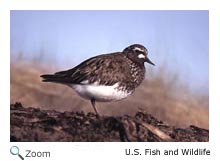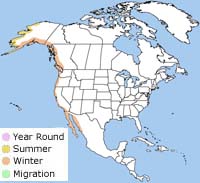Description
 The black turnstone is a short-legged shore bird that is about 9-10 inches in length. It has black to
orange-brown
legs; a short, dark bill that is slightly upturned at the end; and white underwings. In breeding season, its head, back, and chest are black. It has a white belly, white eyebrows, and a white
mustache
at the base of its bill; black and white markings on its head; and a black patch on its chest. In winter, it is grayish-brown on its head, back, and chest. It still has a white belly, but it is missing the white eyebrows and the white patch on its face. Males and females look alike, but the male's coloring is a little brighter, and the female is a little larger. The black turnstone is a short-legged shore bird that is about 9-10 inches in length. It has black to
orange-brown
legs; a short, dark bill that is slightly upturned at the end; and white underwings. In breeding season, its head, back, and chest are black. It has a white belly, white eyebrows, and a white
mustache
at the base of its bill; black and white markings on its head; and a black patch on its chest. In winter, it is grayish-brown on its head, back, and chest. It still has a white belly, but it is missing the white eyebrows and the white patch on its face. Males and females look alike, but the male's coloring is a little brighter, and the female is a little larger.
Range  The black turnstone breeds along the coastline of Alaska. In the winter, the black turnstone is found along the Pacific Coast from Alaska to Baja California. The black turnstone breeds along the coastline of Alaska. In the winter, the black turnstone is found along the Pacific Coast from Alaska to Baja California.
| |
Habitat
During breeding season, the black turnstone is found on marshy coastal tundras. In winter, it is found on rocky shores.
Diet The black turnstone flips over rocks and shells looking food like barnacles and limpets. On the tundra during breeding season, it eats insects, seeds, and berries.
Life Cycle
 The female lays 4 eggs in a nest on the ground. The nest is lined with grass and is in the open or hidden by vegetation. Both parents incubate the eggs for 21-24 days. The chicks are precocial and leave the nest and feed themselves shortly after hatching. Both parents care for the young. The female leaves before the chicks are fledged. The male stays and cares for the chicks until they are 28-30 days old. Male and female pairs may mate for more than one year and use the same nesting spot. The female lays 4 eggs in a nest on the ground. The nest is lined with grass and is in the open or hidden by vegetation. Both parents incubate the eggs for 21-24 days. The chicks are precocial and leave the nest and feed themselves shortly after hatching. Both parents care for the young. The female leaves before the chicks are fledged. The male stays and cares for the chicks until they are 28-30 days old. Male and female pairs may mate for more than one year and use the same nesting spot.
BehaviorThe black turnstone, like the ruddy turnstone, gets its name from its habit of turning over stones and shells when it looks for food.
|



 The black turnstone breeds along the coastline of Alaska. In the winter, the black turnstone is found along the Pacific Coast from Alaska to Baja California.
The black turnstone breeds along the coastline of Alaska. In the winter, the black turnstone is found along the Pacific Coast from Alaska to Baja California.